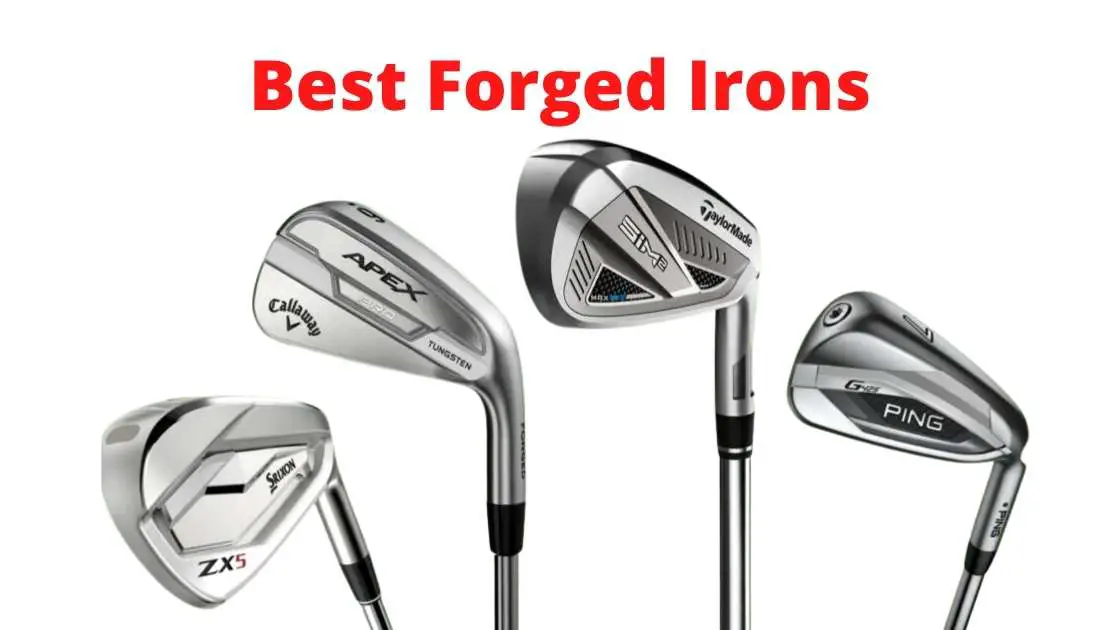The new irons are probably the second most important piece of golf equipment after the driver.
Early in our golf careers, a nice shot with iron usually gets us hooked. As a result, you will need to buy a decent set of irons soon.
With the new forged iron models, you can hit the ball farther and straighter than ever before. Our forged iron recommendation takes your distance, forgiveness, and feel to the next level.
Let's move on to golf iron recommendations.

Which iron model is right for me?
Which golf irons are best for you depends on the individual strengths and weaknesses of your golf game, the type of feel, the sound on impact, and how you like the look of the irons.
While there are only three classifications for drivers and fairway woods, golf irons can be divided into five categories:
- Blades for outstanding golfers (HCP <10)
- Player irons for excellent players (HCP <20)
- Player distance irons for good golfers (HCP <36)
- Mid-handicap irons for the average golfer (HCP >10)
- High-handicap irons for golf beginners (HCP >36)
Depending on the category, the irons have a different structure and offer very little forgiveness (category 1) or a lot of support (category 5). It is essential that the golf irons match your skills and playing style.
What is a forged iron?
The clubmaker has made Irons this way from the start. First, a rough version of the head was created, which was then gradually shaped into the final form with the help of a hammer and anvil. Finally, the shape of the sole was fine-tuned, and the head was polished.
Nowadays, clubs with iron heads are machine forged. A piece of steel is heated and pressed into a mold under great pressure. The forging process is carried out in several steps until the head has its final shape. Finally, the head is given its final finish, and the sole is sanded. In the end, you have a beautiful golf club in your hand - albeit with a relatively small sweet spot.
Forged irons are primarily made for better players who value feel and want to hit balls with specific trajectories. In contrast to the drivers, fairway woods and hybrids, the irons are offered with different shafts.
The most extreme form of forged iron is the muscle back. This should only be used by outstanding players, as it offers little error tolerance. Its main properties are:
1. Weight concentration
The weight of this design is concentrated more behind the sweet spot. The center of gravity is comparatively high and close to the blade. This makes it easier to play the ball with specific trajectories consciously.
2. No offset, narrow top line
The lower edge of the clubface (leading edge) is in the extension of the left side of the shaft (no offset). With this geometry, better players can hit the ball flatter and have more control. Only: The small head looks attractive but reduces the error tolerance significantly.
A narrow top line means that little weight is placed here. The racquet face looks slim. This shape is favored by better players and helps the ball maneuver (shape) better.
3. Narrow sole
Solid ball contact separates the good golfer from the bad. The narrower the sole, the better the skilled player can hit the ball, whether it's lying well or badly. If you swing constantly, you can hit the ball with a narrow sole controlled manner from the hard surface. Narrow sole irons are only for better players.
Alternatives to forged irons
The alternative to forged irons is cast irons. To do this, liquid metal is poured into a mold. This allows manufacturers to create more complex head shapes and multi-material constructions. Since several heads can be produced simultaneously, the casting process is less complicated and cheaper than the forging process. Therefore, cast irons are usually cheaper than forged ones.
The target group for these irons is suitable for all players, from beginners to experts, depending on the head shape.
How many forged irons do I need?
An elementary question, the answer to which depends on various individual factors. The most commonly offered options are 4-PW or 5-PW, or SW, with which the majority of golfers will undoubtedly make a good choice.
Many excellent and outstanding players choose the irons 3 to 9 and buy the wedges separately. Poorer and older golfers and women are well served with 5-SW and can easily replace the long irons with hybrids or fairway woods. But some manufacturers offer wedges that are particularly easy to play for these target groups.
Tips for choosing the best-forged irons
Finally, here are a few general forged iron buying tips that apply equally well to drivers, fairway woods, and hybrids:
1. Testing
Never buy a forged iron without playing it first. All brand companies offer demo events where you have the opportunity to test.
2. Advice
Get expert advice. Do not uncritically nod off all statements made by the seller. Ask for. Get a second opinion if the answers aren't enough for you. Also, don't take well-intentioned advice from friends unless they know the subject.
3. Grip strength
Have your grip strength determined because often, the ones offered as standard are too thick or too thin. Ideally, the tips of the middle and ring fingers of the left hand touch the ball of the thumb very lightly.
4. Swing speed
A sensible adjustment of the clubs is only possible if you know these. It has top priority when selecting the shaft flex.
5. Shaft length
It depends on the body size and the address position. There are clubs with shafts of different lengths to choose from when fitting to find out the right length.
6. Lie angle
Especially important for big and small golfers. Especially with these, a change of one or two degrees up or down can have a decisive influence on the quality of the moment of impact.
7. Fitting
The forged iron golf club has to suit you - not the other way around!

Mike Regan

Mike is a weekend golfer from Connecticut and a devoted fan of the game who turned his passion into the writing experience. Any day he keeps it under 80 is a cool day. When he's not writing about golf his is playing it.

